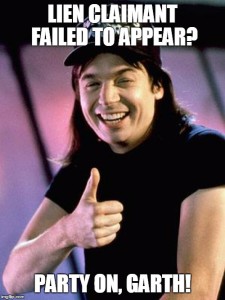Good Morning, dear readers! Your humble blogger has missed you very much, and is so happy to be back on your screen and your e-mail in-box. Just last week, as your humble blogger walked whistling to himself and thinking of more blog post to write, he was confronted with an angry crowd. At first I thought it was a host of applicants’ attorneys, or possibly disgruntled lien claimants. It actually turns out that a recent rage-a-holics anonymous meeting was abruptly cancelled because someone forgot to bring coffee and doughnuts, and your humble blogger just happened to be in the wrong place at the wrong time.
Freshly released from intensive care and after reading several notes that started apologizing and quickly escalated into threatening before calming down to apologizing again, your humble blogger is back and ready for action!
Today, I bring you the story that will warm the heart of anyone who loves IMR – the case of Arredondo v. Tri-Modal Distribution Services, Inc., recently denied review by the Court of Appeal. Applicant’s case-in-chief was resolved via stipulated award with future medical care included, and, invoking this award, the primary treating physician requested authorization for medication, physical therapy, and a back brace. Timely UR denied certification, and applicant appealed using the IMR process. IMR, however, was not timely, having been requested on December 24, 2013, and only issuing an opinion on April 25, 2014, upholding the UR determination.
Applicant had scheduled an expedited hearing, and argued the IMR determination was invalid because it was untimely. Labor Code section 4610.6(d) provides that “[t]he organization shall complete its review and make its determination in writing, and in layperson’s terms to the maximum extent practicable, within 30 days of the receipt of the request for review and supporting documentation…” By contrast, between December 24, 2013 and April 25, 2014 there are 122 days which, pending confirmation from your humble blogger’s accountant, appears to be more than 30.
Following a trial, the WCJ concluded that the WCAB has no jurisdiction to overrule IMR based on an untimely determination, reasoning that 4610.6(g) makes an IMR determination binding on all parties, and, furthermore, the bases for appealing an IMR decision are listed in section 4610.6(h), but limits the remedy upon a successful appeal to a new IMR determination.
In considering applicant’s petition for reconsideration, the WCAB noted that the time limit for an IMR determination is actually up to 45 days – 15 days to provide the relevant information to IMR, and another 30 days after the information has been provided. However, the WCAB affirmed the WCJ’s “determination that the WCAB does not have statutory authority to disregard the IMR determination in this case…”
Under the WCAB’s reasoning, the legislature, in enacting SB-863, meant to have medical treatment determinations made by medical professionals only. Furthermore, the effect of the language of 4610.6(d) is meant to guide the IMR determination, rather than to invalidate the effect of the decision. In other words, 4610.6(d) has no effect if it is disregarded.
One commissioner dissented, however, reasoning instead that IMR should be treated much like UR – if it fails to meet the timeliness requirements as laid out in the relevant statute, it loses its immunity from WCAB review and the issue of medical necessity should be resolved by the WCJ.
Does this issue seem at all familiar, dear readers? Because your humble blogger provided a post back in June – Saunders v. Loma Linda University Medical Group – that addressed a similar issue. In that case, a split panel found that an IMR determination that came in five months after the UR decision was referred to IMR was NOT timely and thus invalid, granting the WCAB jurisdiction to determine whether the requested treatment should be awarded.
So… what’s the answer, dear readers? Does IMR have to come back no later than 45 days after the initial request? Or, can IMR let the injured worker languish and wait for medical treatment? The split in opinion between these two panel cases appears to provide a reasonable basis to seek reconsideration.
But, here’s a scenario for you to consider. UR denies treatment and the injured worker requests IMR. When IMR doesn’t come back two months later, the injured worker files for an expedited hearing. The WCJ rules that, because IMR is untimely, the WCAB has jurisdiction to determine if medical treatment should be awarded as requested, but also concludes that the reasoning articulated in the UR determination is persuasive and declines to award medical treatment. Applicant seeks reconsideration, and the WCAB reverses, awarding the medical treatment instead. Has the defendant lost its opportunity to appeal the determination regarding jurisdiction?
Have a good week, dear readers!


